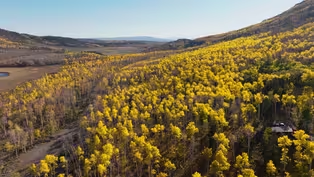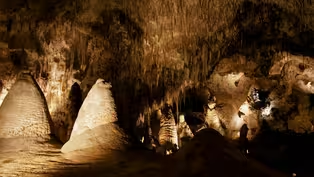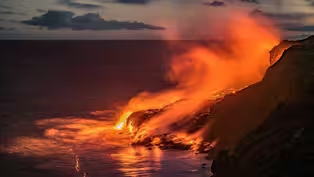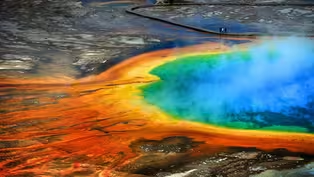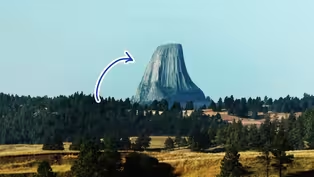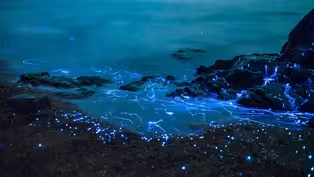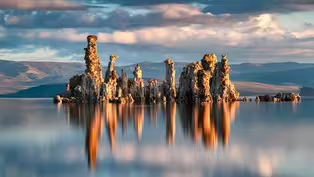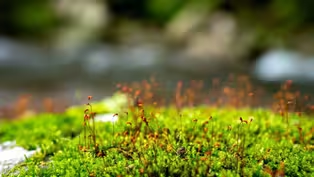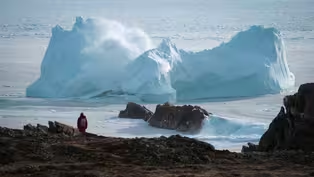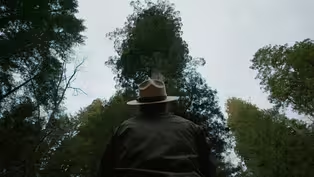
Why Antelope Canyon Never Looks The Same Twice
Season 1 Episode 10 | 6m 49sVideo has Closed Captions
What does it mean to preserve a place that is defined by it's impermanence?
Antelope Canyon might be the most visited and photographed slot canyon in the world, but there is more to this ancient sandstone structure than meets the eye. Formed millions of years ago, and revered as a spiritual site for the Navajo Nation, the origins of this geologic wonder are as fascinating as its beauty is renowned.
Problems playing video? | Closed Captioning Feedback
Problems playing video? | Closed Captioning Feedback

Why Antelope Canyon Never Looks The Same Twice
Season 1 Episode 10 | 6m 49sVideo has Closed Captions
Antelope Canyon might be the most visited and photographed slot canyon in the world, but there is more to this ancient sandstone structure than meets the eye. Formed millions of years ago, and revered as a spiritual site for the Navajo Nation, the origins of this geologic wonder are as fascinating as its beauty is renowned.
Problems playing video? | Closed Captioning Feedback
How to Watch Untold Earth
Untold Earth is available to stream on pbs.org and the free PBS App, available on iPhone, Apple TV, Android TV, Android smartphones, Amazon Fire TV, Amazon Fire Tablet, Roku, Samsung Smart TV, and Vizio.
Providing Support for PBS.org
Learn Moreabout PBS online sponsorshipMore from This Collection
A documentary series from Nature, Atlas Obscura and PBS Digital Studios dedicated to unpacking the stories behind North America's strangest, most unique natural wonders.
Video has Closed Captions
Meet Pando, an ancient tree in Utah that has grown into one of Earth's largest living wonders. (10m 6s)
Truffles Are Hiding a Dirty Little Secret
Video has Closed Captions
How are truffles key to the survival of the forest ecosystem at large? (7m 11s)
This Upside Down Cave Is a Microscopic Warzone
Video has Closed Captions
Microbial warfare has been raging for thousands of years deep below the Chihuahuan Desert. (5m 57s)
This Volcano Won't Stop Erupting
Video has Closed Captions
What does one of Earth's harshest environments teach us about planet survival? (9m 12s)
What NASA Is Looking For In Yellowstone National Park
Video has Closed Captions
At 87º Celcius, the Grand Prismatic Spring is a beacon of microbial life and discovery. (6m 41s)
The Story Behind This Giant Rock in the Middle of a Field
Video has Closed Captions
At 50 million years old, the origins of Devils Tower or Bears Lodge remains a mystery. (6m 57s)
What Makes The “Northern Lights of the Sea” So Magical?
Video has Closed Captions
An ancient and modern mystery, what about bioluminescence inspires such obsession? (8m 26s)
What Are These Strange Towers Growing Out of This Lake?
Video has Closed Captions
Over half a million years old, the story of Mono Lake is one of survival. (8m 54s)
You Aren’t Paying Enough Attention to Moss
Video has Closed Captions
At 450 million years old, moss may hold the key to surviving our rapidly warming planet. (5m 44s)
Why Do Hundreds of Icebergs Keep Visiting This Town?
Video has Closed Captions
What are icebergs doing so close to land and why must we keep an eye on them? (7m 5s)
Redwoods Shouldn't Be So Tall. Here's Why They Are
Video has Closed Captions
What makes the Coast Redwood, a tree as old as the dinosaurs, epically singular in nature? (7m 30s)
Providing Support for PBS.org
Learn Moreabout PBS online sponsorship(upbeat instrumental music) - These are the home of the winds.
That whole cannon would be considered a níłchʼi bighan, breathing holes of the earth where the winds reside down in there.
- All of these shapes are from water that's very turbulent, spinning the sands, spinning the pebbles, just awesome power.
- There's a lot more than just the beautiful photos.
There's history behind the people here, the culture that we share, the respect we have with Mother Nature, the respect that we have with the land.
- [Narrator] You might recognize Antelope Canyon from your desktop wallpaper or your social media feed.
But even though it's one of the most photographed slot canyons in the world, almost every single one of those photos is out of date.
Antelope Canyon is in a perpetual state of flux, constantly being altered by relentless forces of nature.
So what does it mean to preserve something that is defined by its impermanence?
(intriguing music) - We are on the western part of the Navajo Reservation, which is one of the largest Indian reservations in the United States.
This here is Antelope Valley.
You can see LeChee Rock there, Navajo Mountain.
So we're on the border of Utah and Arizona.
Since this has been relatively new and popular with you'd say Instagram and social media, there has been an influx of people wanting to come experience these canyons.
- Antelope Canyon probably receive about over a million people a year.
We see all different sorts from all over the world.
There's one of our very first tour groups that we brought through here told me that this should be the eighth wonder of the world, and I believe it.
- So if we think about the formation process of these canyons, they're fundamentally carved by monsoon flash floods.
We're here above Glen Canyon, which actually has been incised only in the last 250,000 years.
So we get a giant wave of water coming down.
It can appear as a sudden wall of water.
People that hear a flash flood go by often describe whatever the loudest noise that they're familiar with, that's what they choose to describe it.
So the water is very turbulent, transporting cobble sized boulders that are bashing the bed.
So then a slot canyon is very narrow and very deep.
So the key thing that that tells you is the attack by the water is mostly focused at the bottom.
It must cut a hundred times faster at the bottom than it erodes the sides.
There's a lot you can see here about the process of how these canyons are cut.
There's often waterfalls coming down on all sides, and you can see that action on the side here with all these shadows behind every one of the Moki marbles, as this is being blasted by sorta everyday flows, transporting some sand that's sandblasting the side.
But there's also much more powerful effects going on.
These boulders that you see at the bottom here are actually transported in these floods.
And if you look back in here, then you can see all sorts of scales of the turbulence that will occur, vortices spinning through here.
You see this very sharp edge right here?
This is a contact between water out here flowing this way and swirling back around in here, taking the sediment probably up to almost fist size, grinding against the edge and carving this out over time, and driving that erosion by a abrasion process.
It's pretty hard for water to get through such a narrow slot.
You don't wanna be anywhere near it during one of those events, though I have to say I would love to witness one.
(peaceful music) - My family has been in this area for generations.
So we would take our sheep and go into those slot canyons, and this was our playground is what it was.
The one thing that we always got told is you take care of the land, and you always be spiritual.
- Every breath of air we take is sacred.
We're surrounded by and given life through the winds.
It flows through our body.
We carry that wind until we take our last breath and our spirit continues on and follows the holy people.
So when we enter into their home like this, we pay respect to them with their songs and a small prayer.
- As a person, you do your offerings.
That way, the canyon knows you.
The air knows you.
The land knows who you are.
(introspective music) - We do know that it's changing because we have been through several major rainstorms, and we see the power of water.
We've seen Anasazi markings in the canyons, and they're high up.
So you know that as it goes, it has carved deeper and deeper.
- As a stream is going down through here during a monsoon season, sometimes the water level is about 15 to 20 feet high, running through these canyons.
As the flash flood goes through here, it digs down and sometimes it'll replace all the silica at the bottom.
So it changes every storm.
It's gonna change these canyons.
- There are many canyons here in Northern Arizona, Southern Utah, that have a amazing history of filling up with tens of meters of sediment, and then getting re-excavated as climate has changed back and forth over tens of thousands of years.
So long term, it's gonna keep moving upstream, but over the short term, it will fill up and cut back down.
So on an annual basis, you'll find changes.
(peaceful music) - You know, my mother used to say, "You don't own the land.
"The land owns you, and someday it will claim you back."
So because of that, you take care of it, the animals, the plants that live here.
And it's funny that she was right, probably.
I don't know no other place where you can feel like you're near everything sacred.
That's how it is.
- That same relationships we have with all things within nature, the stars, the cosmos, the sun, the moon, to stay in good relationship with those elements.
Everything has a purpose.
Our songs and our prayers that the holy people gave us, we continue those things forward so that life will continue forward.
- [Narrator] Happy Earth Month, everybody.
All this month, PBS is dropping episodes about our amazing planet, like the new video from Indie Alaska about the climate resilience of Alaskans.
Links to that video and the full PBS Digital Studios Earth Month playlist are in the description.
(peaceful music)


- Science and Nature

A documentary series capturing the resilient work of female land stewards across the United States.












Support for PBS provided by:

